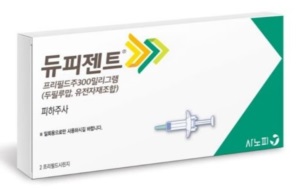Pfizer recently proved the efficacy of its investigational atopic dermatitis drug abrocitinib in a phase-3 study, challenging Sanofi’s Dupixent (ingredient: dupilumab).
Compared to Dupixent, abrocitinib offers a quicker therapeutic effect and a more convenient administration as an oral medication. However, the new agent could not overcome the issue of side effects that appeared in existing Janus kinase (JAK) inhibitors.

Over the weekend, Pfizer announced the results of the phase-3 JADE Mono-1 trial on abrocitinib at the European Academy of Dermatology and Venerology in Madrid.
The results showed that 62.7 percent of the patients treated with abrocitinib 200mg achieved a 75 percent or greater change from baseline in their Eczema Area and Severity Index (EASI) score, compared to 11.8 percent of the placebo group. At the 12th week of treatment, 38.9 percent of the treatment group achieved a 90 percent or greater change in EASI score, versus 5.3 percent of the placebo group.
The proportion of the patients that achieved an Investigator Global Assessment (IGA) score of clear (0) or almost clear (1) skin was 43.8 percent in the treatment group, compared to 7.9 percent in the placebo group. About half of the abrocitinib-treated group showed a therapeutic effect within 12 weeks of treatment.
Even though a head-to-head comparison between abrocitinib and Dupixent is not available, abrocitinib can be considered a more quickly acting drug because Dupixent’s EASI75 response rate and the EASI90 response rate was 48 percent and 33 percent, respectively. The proportion of the patients achieving IGA between 0 and 1 at 162ndd week of treatment was higher in the abrocitinib group (43.8 percent) than the Dupixent group (37 percent).
Despite the positive results, Pfizer will have to tackle the issue of side effects of abrocitinib to make it more competitive against Dupixent.
All JAK inhibitors used in diseases other than atopic dermatitis have received warnings from regulatory agencies due to their dose-dependent thrombosis-related side effects. While about 10 percent of Dupixent users experienced reactions in the injection site and conjunctivitis, around 20 percent of the abrocitinib users had nausea and headache.
“If the newly developed JAK inhibitor is similarly priced with Dupixent, I will choose Dupixent injection despite the convenience of the oral drug,” said a patient surnamed Choi, who is a member of the Korean Atopic Dermatitis Association. “Dupixent seems to be safer.”
As Dupixent is not covered by health insurance, Choi has to visit the hospital frequently to get the prescription drug. “If Dupixent gets reimbursable, however, I would receive many syringes of Dupixent instead of the new JAK inhibitor,” he added.
On Oct. 10, Health Insurance and Review and Assessment Service (HIRA)’s Pharmaceutical Reimbursement Evaluation Committee voted in favor of giving reimbursement to Dupixent. The last stage for the reimbursement will be Sanofi’s drug pricing negotiation with the National Health Insurance Service.
If the Ministry of Health and Welfare’s Health Insurance Policy Review Committee decides the price after price negotiations for about 60 days, the drug will be able to benefit from health insurance in February next year.

